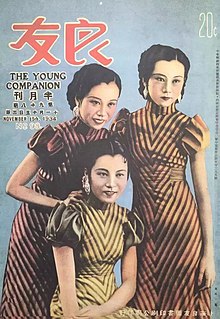Liang Saizhen (梁賽珍), also romanised as Liang Sa-tsen, was a Chinese film actress and dancing girl active in the 1920s and 1930s. She appeared in over 20 films in Shanghai, the vast majority of them silent films. After the Second Sino-Japanese War began in 1937, she fled to British Malaya, and probably died in Singapore.

Filmography
edit| Year | English title | Original title | Role | Notes |
|---|---|---|---|---|
| 1926 | The Deadly Sins | 孽海驚濤 | Lost | |
| 1927 | The Lustrous Pearl | 夜明珠 | Chang Aye Chien | |
| Love Slave | 情奴 | Lost | ||
| 1928 | Spellbound | 迷魂陣 | Lost | |
| A Traveller's Tale | 海外奇緣 | Lost | ||
| The Tiger and a Maid | 猛虎劫美記 | Lost | ||
| The Flying Man | 航空大俠 | Lost | ||
| 1929 | The Seashore Hero | 海濱豪俠 | Lost | |
| Righteousness and Love | 義海情天 | Lost | ||
| The Traitor | 綠林叛徒 | Lost | ||
| The Romantic Heroine | 浪漫女英雄 | Lost | ||
| 1930 | The Burning of the Seven-Star Tower | 火燒七星樓 | Lost | |
| The Bitterness of a Marriage | 百劫鴛鴦 | Lost | ||
| 1931 | The Burning of the Red Lotus Temple | 火燒紅蓮寺 | Films 16–18 in series | |
| An Amorous History of the Silver Screen | 銀幕艷史 | Actress | ||
| Three Darts | 三箭之愛 | Lost | ||
| Join the Army for My Wife | 為妻從軍 | Lost | ||
| The Murderess | 殺人的小姐 | Lost | ||
| Tough Youngsters | 鐵血青年 | Lost | ||
| Who's the Hero? | 誰是英雄 | Lost | ||
| In the Old Peking | 舊時京華 | Lost | ||
| The Tai Chi Dart | 太極鏢 | Lost | ||
| 1932 | Revival of National Spirit | 國魂的復活 | Lost | |
| My Lovely Enemy | 可愛的仇敵 | Lost | ||
| 1934 | Madame Mai | 麥夫人 | Lost | |
| Give Back My Home | 還我山河 | Lost | ||
| Rebirth | 再生 | Lost | ||
| 1935 | The Evil Beauty | 蛇蠍美人 | Lost | |
| Four Sisters | 四姊妹 | Lost |
Personal life
editHer younger sisters Liang Saizhu (梁賽珠), Liang Saishan (梁賽珊), and Liang Saihu (梁賽瑚) also acted in some films. Liang Saizhu appeared in The Seashore Hero (1929), Madame Mai (1934), and Four Sisters (1935), as well as some films after 1935. Liang Saishan only appeared in Madame Mai and Four Sisters, and Liang Saihu only appeared in Four Sisters, which starred the four of them together.The Liang family four sisters raised money for the Anti-Japanese War and had initiated many fundraising activities.
References
edit- Field, Andrew David (2010). Shanghai's Dancing World: Cabaret Culture and Urban Politics, 1919-1954. The Chinese University Press. pp. 124–128. ISBN 978-962-996-373-6.